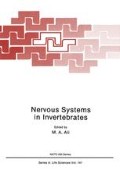Abstract
The nervous system of chaetognatha consists of 6 ganglia in the head region, one ventral ganglion in the body, nerves connecting these ganglia and peripheral nerves passing out of these ganglia. The ganglia in the head region are the cerebral ganglion, a pair of vestibular ganglia, a pair of oesophageal ganglia, and a suboesophageal ganglion. Putative sensory organs are a pair of eyes, the corona (a ciliary loop) behind the eyes, ciliary tufts on the body surface and papillae around the mouth. Decapitated worms lose photoresponsiveness but can swim normally. When the ventral ganglion is ablated, the worms can no longer swim, suggesting that a motor center is located in this ganglion. The nerves from the eyes and the corona run directly to the cerebral ganglion where the sensory information must be integrated. Except for the swimming movements, we can see movements of hooks which participate in grasping prey. A pair of vestibular ganglia have been considered to control these movements. Neither large neurons nor thick fibers have been detected. However, axonal pathways of relatively thick fibers are detected by vital staining using methylene blue. Immunohistochemical studies also gave information on axonal pathways, including neurotransmitter candidates in the nervous system. Serotonin-, methionin-enkephalin-, and neurotensin-like immunoreactivities exist in the nervous system, suggesting that these substances are neurotransmitter candidates in chaetognatha.
Access this chapter
Tax calculation will be finalised at checkout
Purchases are for personal use only
Preview
Unable to display preview. Download preview PDF.
References
Bone Q, Pulsford A (1984) The sense organs and ventral ganglion of Sagitta (Chaetognatha). Acta Zool (Stockh) 65: 209–220.
Bullock TH, Horridge GA (1965) Structure and function in the nervous systems of invertebrates. W.H. Freeman and Company, San Francisco, London.
Burfield ST (1927) Sagitta. Proc Trans Liverpool Biol Soc 41: 1–104.
Duvert M, Barets AL (1983) Ultrastructural studies of neuromuscular junctions in visceral and skeletal muscles of the chaetognath Sagitta setosa. Cell Tissue Res 233: 657–669.
Feigenbaum DL, Reeve MR (1977) Prey detection in the Chaetognatha: response to a vibrating probe and experimental determination of attack distance in large aquaria. Limnol Oceanogr 22: 1052–1058.
Goto T, Yoshida M (1981) Oriented light reactions of the arrowworms Sagitta crassa Tokioka. Biol Bull 160: 419–430.
Goto T, Yoshida M (1983) The role of the eye and CNS components in phototaxis of the arrowworm, Sagitta crassa Tokioka. Biol Bull 164: 82–92.
Goto T, Yoshida M (1985) The maiting sequence of the benthic arrowworm Spadella schizoptera. Biol Bull 169: 328–333.
Grassi GB (1883) Chaetognathi. Fauna Flora Golf. Neapel 5: 1–126.
Hertwig O (1880) Die Chaetognathen: ihre Anatomie, Systematik und Entwicklungsgeschichte, eine Monographie. Gustav Fischer, Jena.
Horridge GA, Boulton PS (1967) Prey detection by Chaetognatha via a vibration sense. Proc R Soc Lond B 168: 413–419.
Hyman LH (1959) Phylum chaetognatha. In: The invertebrates. Vol. 5. McGraw-Hill Book Company Inc., New York. pp. 1–71.
John CC (1933) Habits, structure and development of Spadella cephaloptera. Quart J Microsc Sci 75: 625–696.
Ozaki K, Hara R, Hara T (1983) Histochemical localization of retinochrome and rhodopsin studied by fluorescence microscopy. Cell Tissue Res 233: 335–345.
Pentreath VW, Cobb JLS (1982) Echinodermata. In: Shelton GAB (ed) Electrical conduction and behaviour in simple invertebrates. Clarendon Press, Oxford, pp. 440–472.
Rehkamper G, Welsch U (1985) On the fine structure of the cerebral ganglion of Sagitta (Chaetognatha). Zoomorphol 105: 83–89.
Scharrer E (1965) The fine structure of the retrocerebral organ of Sagitta (Chaetognatha). Life Sci 4: 923–926.
Author information
Authors and Affiliations
Editor information
Editors and Affiliations
Rights and permissions
Copyright information
© 1987 Plenum Press, New York
About this chapter
Cite this chapter
Goto, T., Yoshida, M. (1987). Nervous System in Chaetognatha. In: Ali, M.A. (eds) Nervous Systems in Invertebrates. Springer, Boston, MA. https://doi.org/10.1007/978-1-4613-1955-9_16
Download citation
DOI: https://doi.org/10.1007/978-1-4613-1955-9_16
Publisher Name: Springer, Boston, MA
Print ISBN: 978-1-4612-9084-1
Online ISBN: 978-1-4613-1955-9
eBook Packages: Springer Book Archive

